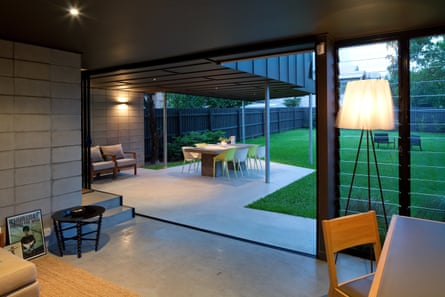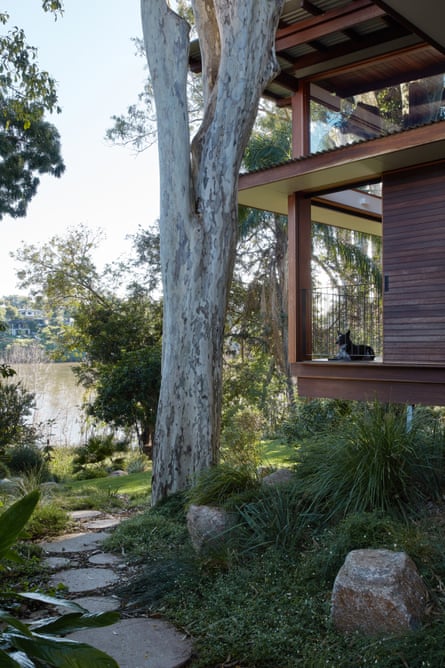[ad_1]
Brisbane architect Paul Worroll has experienced the life cycle of building for floods first-hand.
Worroll and his team at Reddog Architects designed NA house in inner city Brisbane 10 years ago after its owners made the decision to stay put and renovate their property after the 2011 floods.
“The house got raised and then we built underneath … and then there was a discussion about ‘How do we make that area resilient to a catastrophe?’” says Worroll.
“We investigated materials that would be able to be hosed out: a concrete slab, blockwork walls, joinery that could be taken out, the opportunity to open up the area so that if water came through it was able to get through … In other words, not build a container that would fill up.”
Then, with the 2022 floods came the test.
“The house has been, I won’t say impenetrable, but it has been salvaged in a much more holistic way,” says Worroll, adding that his clients always knew there would be some things they would have to replace.
Twelve months on from last year’s devastating floods, Worroll and his fellow architects continue to advocate for adopting a flood-resilient mindset to ensure the city builds back smarter.

“If people are going to acknowledge that their house is still going to be at risk, they need to think about it being like a Meccano set,” he says.
“Maybe the kitchen is built in such a way that they can quickly take it apart … do you think about the ability to take the doors off hinges … to quickly take them out or raise them above where the water is?”
Building in resilience
While architects are only typically involved with about 5% of house builds, Worroll says, the principles of flood-resilient design are accessible to all.
In August, the Queensland government released design guidance for flood-resilient homes, produced in collaboration with JDA Co.
Architect and founder James Davidson, who also collaborated on the government’s flood-resilient building guidance in 2019, says that while buybacks and house-raising are easily understood, retrofitting is more of a mystery.

“If you’ve got a brick veneer house … it’s very difficult to raise, so what do you do?” Davidson says.
The design guidance, much of which can be paid for with Queensland’s $741m resilient homes fund, includes retrofitting strategies and alternate materials that can be used in a range of houses from two-storey double brick homes to single-storey timber, to those raised on stumps.
Common strategies, from wall protection to fixtures, include:
-
raising air conditioning and hot water units on outer walls;
-
replacing closed riser stairs with open – ie no vertical panel between the steps;
-
replacing cavity walls with single skin walls to minimise the chance of mould, or adding weep holes to help dry the wall cavity;
-
fitting removable cabinetry kick boards or installing wall hung bathroom vanities without cabinetry;
-
using flood-resilient grout and sealant when tiling or re-tiling wet areas.
after newsletter promotion
Davidson says despite the common misconception, such strategies and materials, don’t necessarily come at a higher cost.
“In a way we’re not competing with traditional materials like plasterboard. Given they’re non-traditional materials, they’re generally more hardy,” he says.

“When the cost of plasterboard rises because everyone is replacing theirs [after a flood], the cost of these materials doesn’t go up as much.”
Bringing back the Queenslander
A return to the quintessential Queenslander also needs to be considered.
A distinctive mid 19th-century design, the Queenslander is traditionally made of timber with a corrugated iron roof to protect against heat, verandas to provide shelter from sun and rain, and understoreys to naturally ventilate the house.
Matt Kennedy, director and architect at Arcke in Rosalie, Brisbane, lives in one such home in a flood-prone area.
“The understory of a Queenslander construction, they were these wonderful spaces, but they were never designed to be occupied,” Kennedy says.

“It was somewhere to hang out the washing in a period of extended rain, or for the kids to explore. There’s something lovely about the ambiguity of a space like that.”
Kennedy says the growing appetite in recent years to build in under Queenslanders is symptomatic of a wider trend, with the connection between outdoors and place changing, and mass construction geared towards designing insulated boxes that are air-conditioning efficient.
“People are becoming more internalised in their existence,” Kennedy says.
“You’re trying to keep the outside from coming in, but the outside will always come in. Nature will always prevail.”
While building within flood resilient parameters can appear limiting, Kennedy believes there is an opportunity to “create beautiful spaces that do more with less”, particularly as architects start to involve other professionals to understand the hydraulics, flora, fauna and climatology of a site.
Resilient home designs also provide a way of protecting a home’s value in flood-prone areas, with the Brisbane suburb of Fairfield, where Reddog’s NA House stands, seeing a record fall of 24.3% over the 12 months to February 2023.
As people grapple with the impact of the climate crisis and the devastation of increasing flooding, James Davidson emphasises the importance of acknowledging that “just because in a recent event the water went to a particular height, doesn’t mean it won’t go higher”.
While JDA Co is most well known for its work on floods, it has also worked with the Queensland government on bushfire-resilient guidelines, which address extreme heat and have led to a focus on multihazard properties.
“As we were working through those issues with the scientists, we realised there are a lot of building details that could consistently work across flood and fire, and then they naturally work for wind and heat,” Davidson says.
“I think that’s going to become a big part of the Australian building code, and the National Construction Code needs to be a bit more innovative on the multihazard issue.”
But focusing on resilience doesn’t have to come at the expense of beauty, he says.
“You’ve got to balance the poetics and the pragmatics. If you focus too much on one thing … you lose the impact.”
[ad_2]
READ SOURCE


